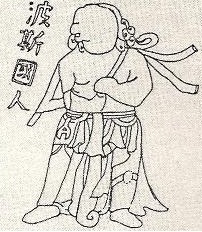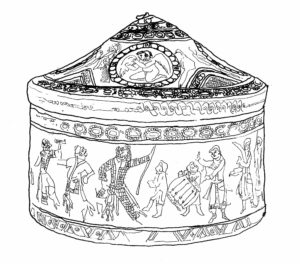Li Sifei 李思飞
Shandong Province 山東 is extremely rich in Buddhist monuments and it is still a very popular destination for pilgrims who continue to visit the region from many parts of China and even Korea and Japan. One of the most well-known sites in Shandong is Qingzhou 青州, owing to the large number of Buddhist statues that have been found there in recent times.

Fig. 1. Foreigners depicted on the garment of a Buddha statue found in Qingzhou. All sketches by the author.
Scholars have been drawn to the statues in Qingzhou for their unique decoration. Some statues even contain painted scenes on the chest of a buddha or bodhisattvas. Among the most interesting painted decorations on these statues are those that depict groups of people from Central Asia. In these depictions, Chinese artists paid special attention to the portrayal of exotic peculiarities, such as caftans and boots, but also prominent noses, curly hair, and beards [Fig. 1]. These characteristics are usually understood by scholars as a reference to people from far western lands, in particular the Sogdians, who were especially active in China during the sixth and seventh centuries C.E. (Qingzhou shi bowuguan 1999: fig. 131).
In this article I would like to highlight those Shandong monuments that have received less scholarly attention. These monuments also include representations of exotic goods or foreigners who travelled along the so-called “Silk Roads” between Central Asia and China in pre-Islamic times. It seems highly probable that claims of Persian identity or Persian artwork, which appeared so prominently in Chinese art and texts during the Northern Zhou, Sui, and Tang dynasties, were actually mediated by Central Asian Sogdians. During these periods, very few Persians arrived in China. By contrast, Sogdians had started to immigrate and settle in Chinese lands at least since the fourth century. In all probability, Sogdian tradesmen, intent on securing a higher price for their services and wares, managed to present themselves and their products as Persian to Chinese elites who were unable to tell the difference.
The “Persian Man” of the Tuoshan Caves
Lesser known Buddhist monuments of the Qingzhou region include the Tuoshan 驼山 Caves, which date to the late Northern Zhou and early Sui period. Among the five grottoes of the Tuoshan complex, the one usually referred to as No. 2 [Fig. 2] presents the image of a person wearing non-Chinese garments. This image has traditionally been referred to by the locals as the “Persian man” (Bosiren 波斯人) (Yan 1957: 33; Li 1998). Images of culturally and ethnically alien peoples appear often in Buddhist art, including the Buddhist art of China during this era. However, in light of the fact that Buddhism is rarely attested to in Persia, this statue of a Persian man in the Tuoshan grottoes is worthy of note.
Between 224-651 C.E., Persia was dominated by the Sasanian Dynasty, and the main religion was Zoroastrianism (also known as “Mazdeism,” after its chief deity Ahura Mazda). Other religions, such as Judaism, Christianity, Buddhism, Hinduism, along with other Zoroastrian “sects,” were practiced by various groups of followers within the multiethnic Persian Empire and were generally not persecuted. In the Margiana and Bactria-Tokharistan regions of the easternmost fringes of the Sasanian Empire, however, Buddhism had many more followers than in the Sasanian core. Not only that, but the Sasanians had been exchanging embassies with different Chinese courts since at least 455 C.E. (Ecsedy 1979: 155).
Peroz III, the son of Yazdigard III (632-651), the last Sasanian sovereign, lived in exile at Chang’an after being welcomed by Tang Gaozong (650-683). Chinese chronicles reported Peroz’s name as Beilusi 卑路斯 and in other related forms, all of which correspond quite precisely to “Peroz.” Peroz was able to obtain a prominent position at the Chinese court. His now headless statue, accompanied by an inscription on the back recording his title, can still be seen at the mausoleum of Emperor Gaozong 唐高宗 and Empress Wu Zetian 武則天 at Qianling 乾陵 (Compareti 2003: 203; Compareti 2009a). The garments on Peroz’s statue include a simple long robe with an undecorated belt and a hanging bag, all quite similar to those of many other statues at Qianling [Fig. 3]. In particular, the hanging bag, usually referred to in Chinese as a pannang 鞶囊 pouch, have long been associated with the Hu 胡 people, a term which was commonly used in Chinese to refer to foreigners, especially Sogdians (Qi 2018).
Because the face of the so-called Persian man in Grotto No. 2 at Tuoshan has been destroyed, it is no longer possible to determine if he had a beard. Though his robe is long and plain, every detail of the opening on both sides on his chest and leather belt are reproduced with precision. These characteristics differ from those of the statue of Peroz at Qianling, though they do resemble those of some other statues of foreigners at that same site [Fig. 4]. Unfortunately, other inscriptions reproduced on the statues at Qianling are extremely enigmatic and it is not always easy to determine the identities of these foreign officials. We might consider the open garments on the chest, like those in the statues at Tuoshan and Qianling, as typical representations of the clothing of people from Central Asia.
It is, however, impossible to identify such people with any precision, given that Persians, Sogdians, Bactrians, Turks, and other Central Asians were all depicted in Chinese statuary. At least one statue at Qianling is portrayed with long hair woven into braids, a feature which might identify him as a Turk. His garment is opened at the chest, but not in the same style as on the statue at Tuoshan. Turks adorned in a robe exactly like that depicted at Tuoshan can also be observed in the mid-seventh century Sogdian painting at Afrasiab [Fig. 5].

Fig. 5. Turks in a Sogdian painting at Afrasiab (pre-Islamic Samarkand). (After: Arzhantseva and Inevatkina 2006: fig 2)
Afrasiab, situated on the northern edge of a settlement that would later become Timurid Samarkand, was one of the richest and most powerful Sogdian cities between the sixth to eighth centuries. Previous studies of Sogdian and Turkish attire have concluded that both of these peoples shared very similar garments and fashion in common (Yatsenko 2009; Yatsenko 2012). In addition, seventh- and eighth-century paintings at Panjikent, an important archaeological site now located in Tajikistan, also depict Sogdian people and deities wearing these types of garments, which are further embellished with decorations commonly referred to as “pearl roundels” [Fig. 6].
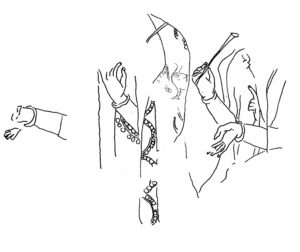
Fig. 6. Sketch of garments embellished with pearl roundels in a Sogdian painting at Panjikent (room 10/sector XVII), The State Hermitage.
At least two images of a “man of Persia” can be found in ancient Chinese art. The “Tribute Office Scroll” (Zhigong tu 職貢圖), now held in the National Museum of China and based on an original by Xiao Yi 蕭繹 of the Liang Dynasty (502-556), is dated to 1077. It reproduces several foreigners, including a “Persian ambassador” (Bosi guo shi 波斯國使) [Fig. 7].

Fig. 7. The “Persian ambassador” in the “Tribute Office Scroll” (Zhigong tu 職貢圖). (After: Compareti 2003: fig 1)
It appears that none of these foreigners were represented accurately, likely due to the fact that Xiao Yi was working from second-hand descriptions (Compareti 2003: 202-3; Compareti 2009a). The other “man of Persia” (Bosi guo ren 波斯國人) can be observed in a ninth-century rock relief in the Jianchuan 劍川 caves in Yunnan Province. As in the Tuoshan statue, the face on this statue was also deliberately destroyed at some point [Fig. 8], and nothing in his garments or accessories indicates Persian fashion (Compareti 2003: 204; Compareti 2009a). In both cases, their identifications as a “man of Persia” is attested to solely by an inscription that is reproduced with the image. Most likely, these “men of Persia” were represented by Chinese artists who did not have the opportunity to observe their subjects first hand.
The Statue of a Monk from Boxing
Neither the “Persian ambassador” in the “Tribute Office Scroll” by Xiao Yi nor the “man of Persia” from the Jianchuan caves reveal any special textile decorations. As mentioned above, among the most typically “Persian” patterns for clothes, the so-called “pearl roundel” was certainly the most popular and widespread.
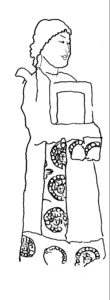
Fig. 9. Sketch of a maidservant wearing a garment adorned with pearl roundels in the wall painting of the Xu Xianxiu tomb.
Although scholars have long considered the pearl roundel decorative pattern as a specifically Sasanian motif, it appears only very rarely in pre-Islamic Persian art. It is more commonly found on late Sasanian rock reliefs and architectural decorations in stucco (Compareti 2005; Compareti 2009b). It is possible that the pearl roundel decorative motif was actually created in Sogdiana, where it is reproduced very often on the clothes of local deities and other people. In China, textiles embellished with pearl roundels appear for the first time as part of the garments worn by prominent figures in the tomb murals of Xu Xianxiu 徐顯秀, an officer who died during the Northern Qi era (550-577). In one case, a wall painting [Fig. 9] contained in the Xu Xianxiu tomb depicts pearl roundels on a saddlecloth and the garments of a servant. Inside each pearl roundel is a single human head, which, because of the headgear, appears to depict a bodhisattva. As is well known, the Northern Qi rulers had very close relations with Sogdian immigrants and were avid patrons of Buddhism. Moreover, Sogdian immigrants are often mentioned in Chinese written sources. Persians, however, who came from a land where Buddhism was scarce, rarely make an appearance in Chinese texts. For this reason, it is much more probable that textiles decorated with pearl roundels were introduced into China by Sogdians rather than Persians (Compareti 2004).
One statue of a Buddhist monk, now kept in the Boxing Archaeological Museum in Boxing 博兴, Shandong, presents some unexpected and extremely interesting details (Zhang 2015). Though the statue is unfortunately badly damaged in the upper part, it is the box in the hands of the monk that has drawn the attention of scholars. Among the precious decorations reproduced in relief on the box is a pearl roundel containing an animal, most likely a bird [Fig. 10]. Boxes like this one have been found in China proper, and others, embellished with very similar decorations, have been excavated in Xinjiang as well (Yu 2018: 165). In at least one Buddhist box (possibly a sarira, a container for holy relics) found by chance around Kucha [Fig. 11] and currently kept in the Tokyo National Museum, typical Iranian pearl roundels can be observed on the upper lid. Due to similarities with such roundels found in China about this time, it is likely that this Kuchean box dates to around the seventh century.
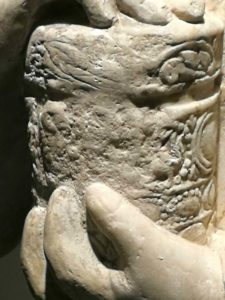
Fig. 10. A box embellished with the pearl roundel decoration in the hands of a Buddhist monk statue. Photo by author.
It is highly probable that the box on the statue from Boxing [Fig. 10] is a detailed reproduction of a precious object that was either imported from abroad or locally produced in a Chinese Buddhist context. Objects like this are extremely rare in Chinese art, though they are described in written sources. According to Chapter 68 of the Chronicle of the Sui Dynasty (Suishu 隋書) during the time of Emperors Wendi 隋文帝 (581-604) and Yangdi 隋煬帝 (604-617), a man of foreign origins called “He Chou” 何稠 was appointed by official decree to produce glazed tiles, glass, and textiles in a “Persian style” in some workshops in the region of Shu 蜀 (modern Sichuan). Unfortunately, no detailed description of this “Persian style” of decorations can be found in Chinese sources. In a recent comment on the “Persian style” textiles produced by He Chou, some scholars proposed to identify those decorations with pearl roundels, which are considered to be typically Persian (de la Vaissière and Trombert 2004: 941).
However, neither the Chronicle of the Sui Dynasty nor other Chinese written sources—including those that include the He Chou biography, such as the Comprehensive Mirror to Aid in Government (Zizhi tongjian 資治通鑒)—reveal such a precise description. The Chronicle of the Sui Dynasty only mentions a golden thread woven together with that Persian textile, but no pearl roundels. Moreover, the surname of He Chou clearly points to origins in central Sogdiana, more precisely in Kushanya. As already proposed by Matteo Compareti, it is very likely that skilled Sogdian merchants represented their own products as Persian to various Chinese courts so as to increase their aura of exoticism and thus fetch a higher price for their sale (Compareti 2011).
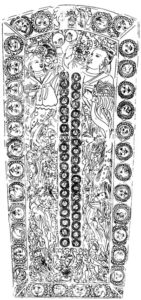
Fig. 12. Coffin surface embellished with pearl roundels from the Li He tomb. (After: Finsterbusch 1976: pl. 14)
As already mentioned above, pearl roundel decorations appear very rarely in Chinese art. The only other obvious specimen to be found in China proper is represented by the Li He coffin of the Sui Dynasty period. The edges of the coffin are embellished with pearl roundels [Fig. 12] that contain the heads of various humans, animals, and monsters (Finsterbusch 1976: pl. 14). It is worth observing, however, that Li’s personal name, as revealed on his epitaph, was Li Shijun, which reminds us of the Sogdian Shi Jun/Wirkak, whose sarcophagus was found in Xi’an (Shaanxi sheng wenwu guanli weiyuanhui 1966: 33). Another possible example of the pearl roundel motif was identified on the belt of a sixth-century Buddhist statue from Sichuan, though upon closer examination it does not seem to be exactly the same pearl roundel decoration (Shi 2014: 81-90).
During recent excavations at Shoroon Bumbagar in Mongolia, archaeologists uncovered an early seventh-century Turkish tomb in classic Tang style (Erdenebol 2017: fig. 16). Among the finds were many funerary statuettes (mingqi 明器 or 冥器), some of which evinced garments embellished with pearl roundels. At least one other such funerary statuette has been found in an early tomb of the Astana cemetery in Turfan, and is now kept in the Xinjiang Museum in Urumqi (Gasparini 2014: fig. 7). Some other Tang funerary statuettes, excavated at the tomb of Prince Yi De 懿德 at Qianling, are in the shape of mounted soldiers, whose equine armor [Fig. 13] is embellished with pearl roundels. It is difficult to determine if these soldiers should be classified as being of Chinese or foreign origin, though the presence of pearl roundels suggests a foreign origin.
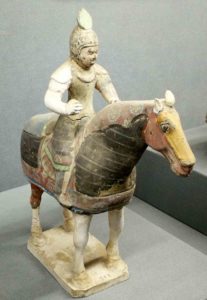
Fig. 13. The statuette of a mounted soldier whose equine armor is embellished with pearl roundels, from the tomb of prince Yi De at Qianling. Photo by author.
For all of these reasons, it does not seem that the Chinese upper classes demonstrated any particular affection for pearl roundels on textiles or other objects. On the contrary, it was likely foreigners living in China or “barbarized” Chinese living in Turfan who tended to appreciate this kind of decoration. In all probability, however, pearl roundels were not a pure Sasanian or Persian creation, but were instead most likely a product of Sogdian weavers and artists who represented their goods as “Persian.” The production of textiles embellished with pearl roundels, it seems, was a specialty both in the Sogdian motherland and in the Sogdian communities of China.
Conclusion
From the Northern Zhou to the mid-Tang era, the upper classes of China seem to have identified “men of Persia” (Bosiren or Bosi guo ren) as the most refined producers of exotic goods from the Western Regions. This is curious, for, as we have seen, it was the Sogdians who, by at least the fourth century C.E., constituted the earliest and most numerous migrants into China from western lands. Persians, however, did not arrive in Chinese courts until several centuries later. Not only were “Persian” products highly esteemed in China, but the image of the “vicious Persian magician” also started to appear as a protagonist in Chinese fiction during the Tang dynasty (Schafer 1951). And yet it is unlikely that precise information about Sasanian Persia circulated in China proper during this time frame. Therefore, it seems probable that some “Persian” goods presented at Chinese courts by westerners during this era were not presented by actual Persians or even produced in an authentic Persian style. Rather, they seem to have been products of the Sogdian homeland in Central Asia or were produced by Sogdians living in China, such as was evident in the case of He Chou.
Undoubtedly, the Chinese had some knowledge of the Persians, and it is possible that Chinese artists might have been able to model their works on those Sasanian envoys who began to arrive in the territory of China in the mid-fifth century (Compareti 2003). But it seems probable that the image of “Persia” that most Chinese elites held—a wonderful land from whence glass, metalwork, textiles, and other exotic goods originated—was mediated largely by the Sogdians. Perhaps it is for this reason that the statue of a generic foreigner from the west is still identified by the local people of Shandong as a “man of Persia,” even if it was probably a Sogdian or a man from another Central Asian region.
About the Author
Li Sifei 李思飞 is an independent scholar. She received her B.A. in art design from Beihang University, and her M.A. in philosophy from the Chinese Academy of Social Sciences. Her main interests focus on Hellenistic art and culture in Asia, along with cultural interactions between China and the West along the Silk Road. She is the author of Shenxing, renxing, shixing de jiaoxiang: Xila renti diaosu yishu shangxi 神性, 人性, 诗性的交响:希腊人体雕塑艺术赏析 [Symphony of divinity, humanity and poetics: an appreciation of Greek statuary] (Nanjing, 2016). E-mail: <lsf_1019@126.com>.
References
Arzhantseva and Inevatkina 2006
Irina Arzhantseva and Olga Inevatkina. “Afrasiab wall-painting revisited: new discoveries twenty-five years old.” In: M.Compareti and É. de la Vaissière , ed., Royal Naurūz in Samarkand: Proceedings of the Conference Held in Venice on the Pre-Islamic Paintings at Afrasiab, Pisa-Roma: Accademia, 2006, 185-212.
Compareti 2003
Matteo Compareti. “The Last Sasanians in China.” Eurasian Studies II/2 (2003): 197-213.
Compareti 2004
———. “The Sasanian and the Sogdian ‘Pearl Roundel’ Design: Remarks on an Iranian Decorative Pattern.” The Study of Art History 6 (2004): 259-72.
Compareti 2005
———. “Sasanian Textile Art: An Iconographic Approach.” Studies on Persianate Societies 3 (2005): 143-63.
Compareti 2009a
———. “Chinese-Iranian relations: The Last Sasanians in China.” Encyclopaedia Iranica. Available online: http://www.iranicaonline.org/articles/china-xv-the-last-sasanians-in-china
Compareti 2009b
———. “Sasanian Textiles: An Iconographical Approach.” Encyclopaedia Iranica. Available online: http://www.iranicaonline.org/articles/sasanian-textiles
Compareti 2011
———. “Un sogdiano alla corte cinese: qualche osservazione sulla biografia di He Chou.” In: G.G. Filippi ed., Il concetto di uomo nelle società del Vicino Oriente e dell’Asia Meridionale. Studi in onore di Mario Nordio, Venezia: Cafoscarina, 2011: 227-37.
Ecsedy 1979
I. Ecsedy. “Early Persian Envoys in the Chinese Courts (5th-6th Centuries A.D.).” In: J. Harmatta, ed., Studies in the Sources on the History of Pre-Islamic Central Asia, Budapest: Kiadó, 1979: 153-62.
Erdenebol 2017
L. Erdenebol. “Preliminary Excavation Findings from Shoroon Bumbagar, Ulaan Kherem, Mongolia.” In: E. Allinger et al., eds., Interaction in the Himalayas and Central Asia: Processes of Transfer, Translation and Transformation in Art, Archaeology, Religion and Polity, Wien: Verlag der Österreichischen Akademie der Wissenschaften, 2017: 29-54.
Finsterbusch 1976
K. Finsterbusch. Zur Archäologie der Pei-Ch’i-(550-577), und Sui-Zeit (581-618). Wiesbaden: Franz Steiner Verlag, 1976.
Gasparini 2014
M. Gasparini. “A Mathematic Expression of Art: Sino-Iranian and Uighur Textile Interactions and the Turfan Textile Collection in Berlin.” Transcultural Studies 1 (2014): 134-63.
Li 1998
Li Yuqun 李裕群. “Tuoshan shiku kaizao niandai yu zaoxiang ticai kao” 驼山石窟开凿年代与造像题材考 [Research on the cutting period and statuary themes in the Tuoshan Caves]. Wenwu 文物 (1998), No. 6: 47–56.
Qi 2018
Qi Xiaoqing 祁晓庆. “Pannang ji Huren peinang xisu kao” 鞶囊及胡人佩囊习俗考 [Studies on pannang pourches and the custom of pouch wearing among the Hu people]. Huaxia kaogu 华夏考古 (2018), No. 2: 78–85.
Qingzhou shi bowuguan 1999
Qingzhou shi bowuguan 青州市博物馆. Qingzhou Longxing si fojiao zaoxiang yishu 青州龙兴寺佛教造像艺术 [The art of Buddhist statues at Longxing Temple in Qingzhou]. Jinan: Shandong meishu chubanshe, 1999.
Schafer 1951
E.H. Schafer. “Iranian Merchants in T’ang Dynasty Tales.” In: W. J. Fischell, ed., Semitic and Oriental Studies: A Volume Presented to William Popper, Berkeley and Los Angeles: University of California Press, 1951: 403-22.
Shaanxi sheng wenwu guanli weiyuanhui 1966
Shaanxi sheng wenwu guanli weiyuanhui 陕西省文物管理委员会. “Shaanxi sheng Sanyuan xian Shuangsheng cun Sui Li He Mu qingli jianbao” 陕西省三原县双盛村隋李和墓清理简报 [A brief report on the Li He tomb from the Sui dynasty in Shuangsheng village, Sanyuan County, Shaanxi Province]. Wenwu 文物 (1966), No. 1: 27–33.
Shi 2014
Shi Ruoyu 师若予. “Liang datong sannian folixiang yidai wenyang de chubu yanjiu: jian tan Shu jin zhong de xiyu yinsu” 梁大同三年佛立像衣带纹样的初步研究: 兼谈蜀锦中的西域因素 [Preliminary research on the drapery of the costume of the standing Buddha statue from the third year of the Datong era in the Liang dynasty: elements of the Western Regions in Shu brocade]. Kaogu 考古 (2014), No. 11: 81–90.
De la Vaissière and Trombert 2004
Étienne de la Vaissière and É.Trombert. “Des Chinois et des Hu. Migration et integration des Iraniens orientaux en milieu chinois Durant le haut Moyen Âge.” Annales 5-6 (2004): 931-69.
Yan 1957
Yan Wenru 阎文儒. “Yunmenshan yu Tuoshan” 云门山与驼山 [Yumenshan and Tuoshan]. Wenwu cankao ziliao 文物参考资料 (1957), No. 10: 30–33.
Yatsenko 2009
S.A. Yatsenko. “Early Turks: Male Costume in the Chinese Art: Second Half of the 6th- First Half of the 8th cc. (Images of ‘Others’).” Transoxiana 14 (2009).
Yatsenko 2012
———. “Sogdian Costume in Chinese and Sogdian Art of the 6th-8th Centuries.” In: G. Malinowski, A. Paroń, B. Sz. Sznoniewski, eds., Serica-Daqin: Studies in Archaeology, Philosophy and History of Sino-Western Relations, Wrocław: GAJT Press, 2012: 101-14.
Yu 2018
Yu Wei 于薇. Shengwu zhizao yu zhonggu Zhongguo fojiao sheli gongyang 圣物制造与中古中国佛教舍利供养 [The making of sacred goods and Buddhist reliquaries in medieval China]. Beijing: Wenwu chubanshe, 2018.
Zhang 2015
Zhang Shumin 张淑敏. Boxing wenhua daguan: fojiao zaoxiang juan 博兴文化大观: 佛教造像卷 [A overview of Boxing culture: Buddhist statues volume]. Beijing: Zhongguo wenshi chubanshe, 2015.




